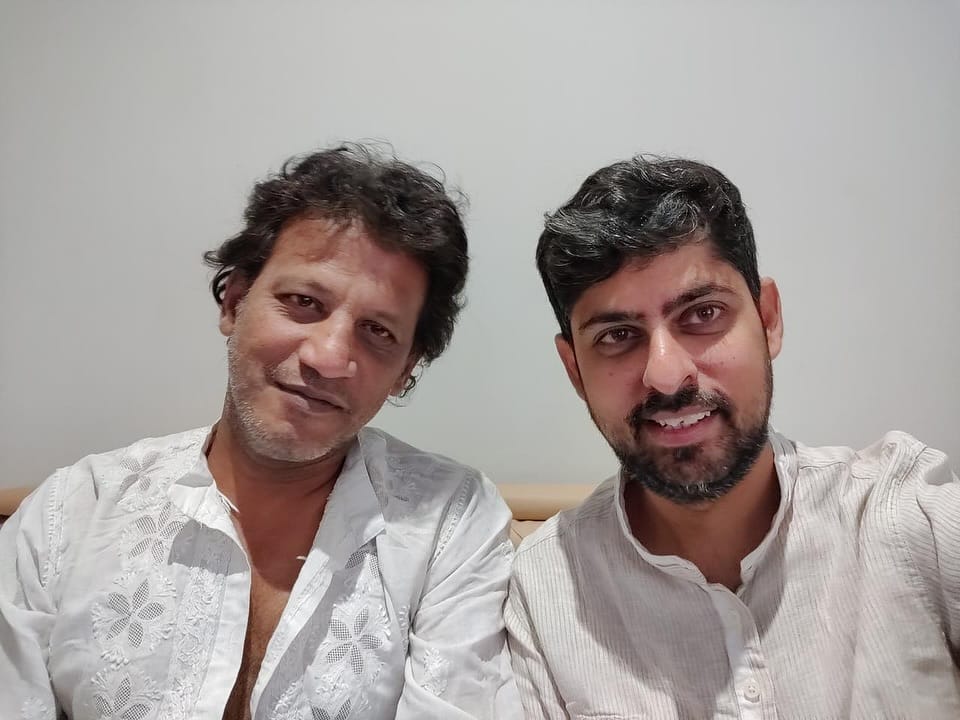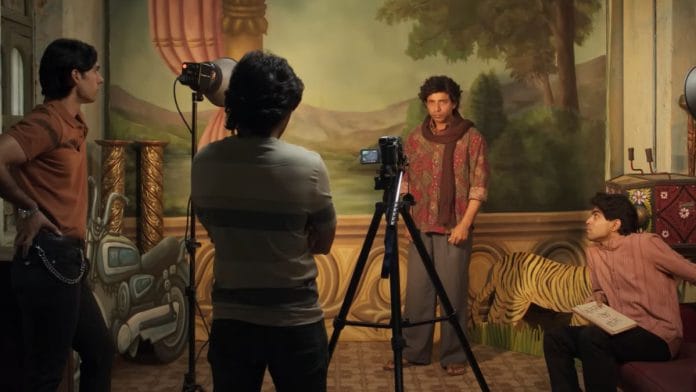New Delhi: A small textile town in Maharashtra echoing with the sound of power looms, battling with the bomb blast label and yet rebounding with an unputdownable movie obsession became the inspiration for the award-winning documentary film called Supermen of Malegaon in 2008 by Faiza Ahmad Khan. That film, in turn, is the inspiration for Reema Kagti’s Bollywood movie Superboys of Malegaon.
It’s an inspiration loop.
The documentary film made Bollywood writer Varun Grover curious about the small town, its people and cinematic spirit. But that curiosity soon evolved into an examination of the politics, cinematic gaze, and counter-culture.
When producer Zoya Akhtar approached Grover in 2019 for Superboys of Malegaon, it was a dream come true, and they decided to start from scratch, independent of the documentary. “I kept in touch with Farogh after meeting him at a screening of the documentary. It was through him I found out more about Malegaon. I had the greed to tell the story in some format,” said Grover.
Farogh Jafri is one of the stars of the 2008 documentary. He was the screenwriter of the spoof films produced in Malegaon. Jafri passed away in 2020.

Superboys of Malegaon looks at a crew of amateur filmmakers who create nothing short of a cultural revolution in Maharashtra’s Malegaon, with parodies of films like Sholay and Superman.
Filmmaker Nasir Shaikh (played by Adarsh Gourav) and his friends make movies while juggling their day jobs—cotton mill worker, video parlour owner, and a lecturer.
The commercial movie adds its own critical thinking into the mix of Malegaon’s lived experiences and Faiza Khan’s documentary narrative.
From portraying the writer, Farogh, as the real ‘hero’ of a film to fleshing out two strong female characters asserting their right to live the lives they want, Superboys of Malegaon takes Khan’s documentary forward, while acknowledging her valuable contribution.
In Khan’s documentary, the focus was the making of the people’s movie, Malegaon ka Superman. But in the film made by Reema Kagti and written by Varun Grover, Malegaon’s journey of making films is also about the triumph of friendship between Shaikh, Farogh, and other members of the crew, united by their love for cinema.
“Who decides what is art? We call Malegaon cinema as poor people making cinema with a patronising gaze. Part of me felt that the documentary also had a gaze. I wanted to get away from it,” said Grover. The film’s end credits, however, give a shout-out to Khan and her documentary.
The question of gaze is important. But in the documentary, Khan’s camera enters a space that has largely been hidden from the public. It almost looks wide-eyed at this jugaad film industry. In one scene, for instance, when Nasir Shaikh climbs a power transformer to shoot a scene, Khan asks, “Do you have the permission?”
The question was coming from someone who had worked in a large industry with formal ways of working.
A 2012 review of the documentary specifically addressed the gaze. Journalist and author Anna MM Vetticad wrote: “Supermen of Malegaon could have adopted a patronising tone towards small town folk or exoticised Malegaon for big city viewers. That Faiza Ahmad Khan does nothing of the sort is just one of her many achievements in this incredibly layered, yet incredibly simple, film”.
Grover, on the other hand, builds a tale of friendship and of the spirit of filmmaking, incorporating sub-plots that help avoid the paternalistic gaze.
What piqued Grover’s interest was the fact that the filmmakers were not bogged down by the sheer challenges of making a movie—budgetary constraints, lack of trained technical expertise to equipment. “In a town like Malegaon, where few things are in their control, they create something out of nothing and that was fascinating,” said Grover.
There is no infrastructure for filmmaking in Malegaon, and the struggle to make ends meet is a persistent reality for Shaikh and his friends. There is also the pressure to conform and pick up family business or simply ‘settle down’, as shown in Kagti’s film. Despite this, and zero budget, Shaikh decides to make films, instead of sitting on the fence and simply watching them. For his friends, it is about supporting Shaikh’s dream, because that is what friendship means to them.
Faiza Khan and her documentary
Faiza Khan had just finished assisting on the 2007 film Anwar and was a bit disenchanted with the money-driven industry. By contrast, the Malegaon film industry had none of the resources of Bollywood but sheer passion for cinema made up for any lack.
“I was quite influenced by Iranian cinema and wanted to try to work with this form that blurs the boundaries between documentary and fiction,” said Khan.
She, along with a co-producer, jumped on a bus to Malegaon to meet the men who would make movies in their free time, after their respective day jobs.
“In the first ten minutes of our meeting, Nasir said that he wanted to make Malegaon ka Superman. It was the core idea, and then we started to uncover the dynamic of the place and that starts to form layers around the central idea,” Khan said.

Khan arrived in Malegaon just after the 2008 blast. A thriving film industry run largely by Muslim men with a strict policy about not letting local women work in those films, was also an aspect Khan and her team wanted to explore.
Khan said Nasir Shaikh and his motley crew thought she and her team would leave in a matter of 3-4 days, like many news crews before her. But she was here not just to make the documentary, but also to go deeper into what makes Malegaon a fascinating space.
“We would be at Nasir’s house every morning, with our cameras, ferrying microphones and battery packs and tripods. At some point, he even got a little exasperated with us,” she said.
But he soon started to understand why Khan needed to do what she was doing. “We moved beyond that, beyond his initial exasperation, and that was when so many things started to become accessible to us. We became part of their process of making the film Eventually, it led to a rapport and that enabled us to develop our film together,” Khan added.
Once the documentary came out, the lives of the four friends in Malegaon changed. Shaikh was asked to direct a series of episodes for a comedy show, Sony SAB’s Malegaon ka Chintu, for which many of the Malegaon filmmakers travelled to several countries to shoot.
Nasir went back to Malegaon after that and was never lured by the industry in Bombay. “The risks and precariousness were too high,” he had said in Khan’s documentary. Akram, who played the villain, runs a very successful YoutTube channel making comedy sketches which has lakhs of views, and over 71k subscribers.
Khan’s film was screened at over thirty global film festivals and won as many as 15 awards, including the Jury Prize for Best Documentary at the Asiatica Film Mediale in Rome.
In 2012, PVR was screening indie films and documentaries under its Director’s Rare programming and Supermen of Malegaon also released in theatres. “We had a pretty good theatrical run for a month and then a DVD release. Since then, the film has been publicly available and even though we’re chided for not taking action against our pirated film, that has allowed it to continue to be watched.
Groups like Cinema of Resistance have been screening the film for years in small towns and, thanks to them, the film still continues to find an audience after all these years,” said Khan. Cinema of Resistance is a grassroots film screening initiative that works on bringing alternative films or new cinema to small towns, villages, and community venues.
Also read: What didn’t make it into Black Warrant? Tihar prisoner song that labels everyone criminals
Making of Superboys of Malegaon
The importance that Grover gives to writers shows up in a scene from Superboys of Malegaon. “Writer baap hota hai,” says Farogh (played by Vineet Kumar Singh).
“Writers have a perfect mix of superiority complex and persecution complex, and we wanted to bring it into the scene,” said Grover, adding that it was actually Singh who improvised the line.
“The industry is not centred around writers, so it might sound delusional. But it’s a declaration that is very much understood by everyone–that there is no great film without a great script,” said Grover, who has been a passionate advocate in the battle for credit and compensation of writers in the film industry.
Right after the fight with Nasir in the movie, Farogh decides to go to Mumbai to try his luck. “We decided to send Farogh to Mumbai, because no one is making art. It is all commercial cinema so what is the difference between the commercial cinema of Mumbai and Malegaon then. Wanted to ask the question,” said Grover.
The other notable intervention is squeezing in more screen time for the stories of Malegaon’s women that show how one has to operate within the deeply restrictive confines of a patriarchal setup.
“We wanted strong female characters who have agency and are not mere props or just a love interest,” said Grover. Nasir’s wife Shabeena (Muskkaan Jaferi) is the one who gives him her savings to make the film. She, however, asks Nasir for credits as producer.
Shabeena also makes her husband promise on their wedding night that he would convince the family’s head, his brother, to let her continue her legal studies. Trupti (Manjiri Pupala), who plays Basmati in Nasir’s debut movie, Malegaon Ka Sholay, faces domestic abuse by her husband, but keeps nurturing her lofty dreams of getting a separate makeup auto, making money from acting, and eventually getting out of her abusive marriage. Grover hopes that someday, an all-female crew would make a movie in Malegaon.
He went to Malegaon and spent time with Shaikh and his friends while researching for the film. After the release, Grover also penned a post with pictures taken in Malegaon. “The film—like all films—took half-a-decade to materialise. And the film business will give us 3 days to label it as success or failure,” wrote Grover.
Also read: Sridevi didn’t need VFX for horror. Nagina was a blockbuster
More from Malegaon
Both Khan and Grover agree that there are many more stories yet to come out of Malegaon. Ruchika Negi’s 2013 documentary Malegaon Times, for example, explores the idea of performance in the working class through the character of Asif Albela, who is a mimic, stage performer, and actor.
Khan also mentioned a film about women Urdu poets, with one of them being from Malegaon. It’s currently under production.
“There is another bit of interesting history to Malegaon that was pointed out to me when working on a film with the Handloom Futures Trust. Handloom weavers faced unemployment in UP over the decades, they would migrate to Malegaon and areas around it. There’d be a wealth of knowledge about weaving that is probably largely lost as power looms dominate the landscape,” said Khan.
Beyond its supermen and superboys, Malegaon is a gift that keeps giving. Its stories are many and the gaze has just begun.
(Edited by Aamaan Alam Khan)






